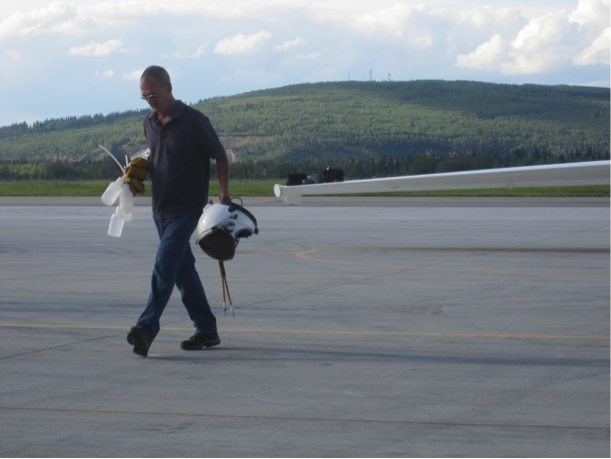As the ER-2 pilot got ready for his first flight out of Fairbanks, I wondered what it’s like piloting the aircraft, all by himself, 65,000 feet up.

Denis Steele sets up a video camera in the cockpit of the ER-2, 65,000 feet over Alaskan mountains and glaciers. (Credit: Denis Steele/NASA)
The NASA ER-2 pilots for this campaign, Tim Williams and Denis Steele, are flying the MABEL instrument to study the glaciers and ice sheets. Before they fly, they have to get suited up. It’s quite a process. Because the altitude is so high, they need to wear pressure suits. I talked with expert NASA engineer technicians Raul Cortes and Ryan Ragsdale, who are veterans in testing equipment and prepping pilots before a flight to ensure safety.
The involved process starts the day before a flight, when Cortes and Ragsdale prepare the pressure suit. They check the pressure and make sure there are no leaks in the gloves, body suit, and helmet. They put the whole system together and inflate it, like a giant balloon character, to test that the suit will properly pressurize.

Engineer Technician Ryan Ragsdale of NASA Dryden inflates the pressure suit the day before to make sure there are no leaks. (No, there is not a real person in there!). (Credit: Valerie Casasanto/NASA)
When a pilot puts on the suit, it’s bulky and stiff, so it’s difficult to work in. And it’s difficult to eat in. During the long flights, pilots eat and drink out of a straw.
The food is the consistency of pudding, and the straw feeds through a small hole in the helmet of their pressure suit. I asked what was on the menu for one flight. They have a choice that includes beef stroganoff, pears, caffeinated chocolate pudding (which happens to be Cortes’ and ER-2 crew member Luis Rios’ favorite). I was curious about this chocolate pudding, but given a free sample of the “pears” — which tasted like part baby food, part applesauce, with a pear afternote.
The caffeinated chocolate pudding used to be Williams’ favorite until he switched to the caffeinated apple pie. Mmmm, wonder if there are crusts in there too. When Steele first started flying, he ate the tube food. But sometimes it would get messy. One time a pilot was heating up a “sloppy joe” tube and it accidentally squirted out all over the cockpit. Now Steele just drinks water. You can easily dehydrate up there since you are breathing pure oxygen.
I thought it must be pretty confining in that suit with not much room to move, so talked with the Steele and Williams to see what the space is like for their 8-hour journey. The cockpit seemed to be about the size of half of a bob sled. Or, according to Steele, “if you throw a blanket over your head and body and lift your arms out a little, it’s that area between you and the blanket.” Just a little bit of room to move around, and a bit of leg room (unless a pilot is really tall). However, it doesn’t feel claustrophobic, Williams said, because they have good visibility.
When they’re up in the stratosphere, pilots keep a close watch on the plane’s instruments, Steele said. “You are always thinking – watching the instruments, doing science, mental math, calculations, thinking about what you would do in an emergency situation.”
They even do puzzles. On one flight last week Williams did Sudoku to keep entertained. You can also plug in to play music, although there are stories of colleagues playing tricks on the pilots, and programing in Disney music prior to flight.
Long flights at high altitudes do have effects, Steele said, and pilots need to be careful and not exercise too much after they land.

Ryan Ragsdale carries empty water bottles and pilot’s helmet back to hangar after a long day’s flight. (Credit: Valerie Casasanto/NASA)
“Being at 60,000 ft. does drain you, especially if you are working hard,” he said. “The time you are working hardest is when you take off and land. The pilot does a lot of movements to keep the plane stable at low altitudes. It wears you out. But you get used to it, it’s like driving a car!”







Fascinating. All the prep time, mental gymnastics , would all be worth it to see Earth from that altitude.
Thanks for sharing
!:+0
Oh reminds me of the SR-71 pilot stories; gosh, it MUST have been funny when the colleagues pulled that Disney prank
Very very interesting!. I would love to read more information on the physiological effects of traveling at 60,000 ft .
Our lab routinely performs altitude simulation tests to assess fitness to fly. That’s child’s play compared to the amazing work you do. Well done!
Thank you for the amazing insight. I am always ready to hear more like this.
Greetings:
As a former Naval Aviator/Mechanic, I would be interested in working flight preparation and operations follow up with your group.
I live near DME and would be willing to travel anywhere in the desert Southwest.
The VA covers my medical requirements wherever I travel in the US.
Yours,
Lynn Riggs
I would do this in a heartbeat! Hey guys I already passed my centrifuge test for Virgin Galactic . No fooln!!!
wonderfil article! Love reading about what it’s like to prep & fly these birds!!’ Thank you so much. Look forward to more.
gracias por sus atenciones móvil Alcatel adobe reader now/ aéreo help